Last Updated on November 3, 2021 – 9:19 am
Learning from experience is the number one way that employees develop, according to various studies. Yet, companies focus considerable time and money on the further growth and development source: education/online training. For example, U.S. companies spend an estimated $13.6 billion annually on leader development (O’Leonard & Loew, 2012). “The vast majority of this investment goes toward education and training. In contrast, the average percent of experience-driven leader development solutions range from 9% for first-level supervisors to 14% for senior managers.” The number one reason for this trend is because companies don’t know how to develop employees through experience.
Here are four practices from the leading companies that will help you develop the best possible talent in your organization (source: Experience-Driven Leader Development).
1. SAP and High Potential Fellowship Program
Through a “High Potential Fellowship Program,” SAP offers an opportunity for high potentials to work full time on strategic projects in different functions or countries for six months. At the end of the fellowship program, the participants return to their original roles.
There are two six-month fellowship cycles each year. Managers identify convenient opportunities in their areas for a fellow. After HR created all the job requisitions, they launched the cycle is to all high potentials via email. Interested high potentials talk to their direct managers to determine whether a fellowship supports their development goals and discuss how they could cover their home responsibilities during a six-month absence. If the high potential and the direct manager agree that a fellowship opportunity aligns with the individual’s development goals, the high potential can apply. Managers/mentors at receiving teams accept online applications, determine whether to interview an applicant, conduct interviews and then offer viable candidates. When a fellowship seat is filled, the job posting is withdrawn from the eRecruiting system. An HR contact supports both the fellow and the manager/mentor for each position through the process.
As a fellowship begins, the fellow and the receiving team manager clarify performance objectives for the fellowship and the learning and development goals for the fellow. HR function provides a simple template for this. At the year-end performance review, the receiving manager/ mentor serves as an “additional appraiser” to ensure the individual’s contributions during the fellowship are taken into account.
After their assignments, fellows write reports summarizing their accomplishments and lessons learned. The reports are shared with the fellowship manager/ mentor and home-team manager.
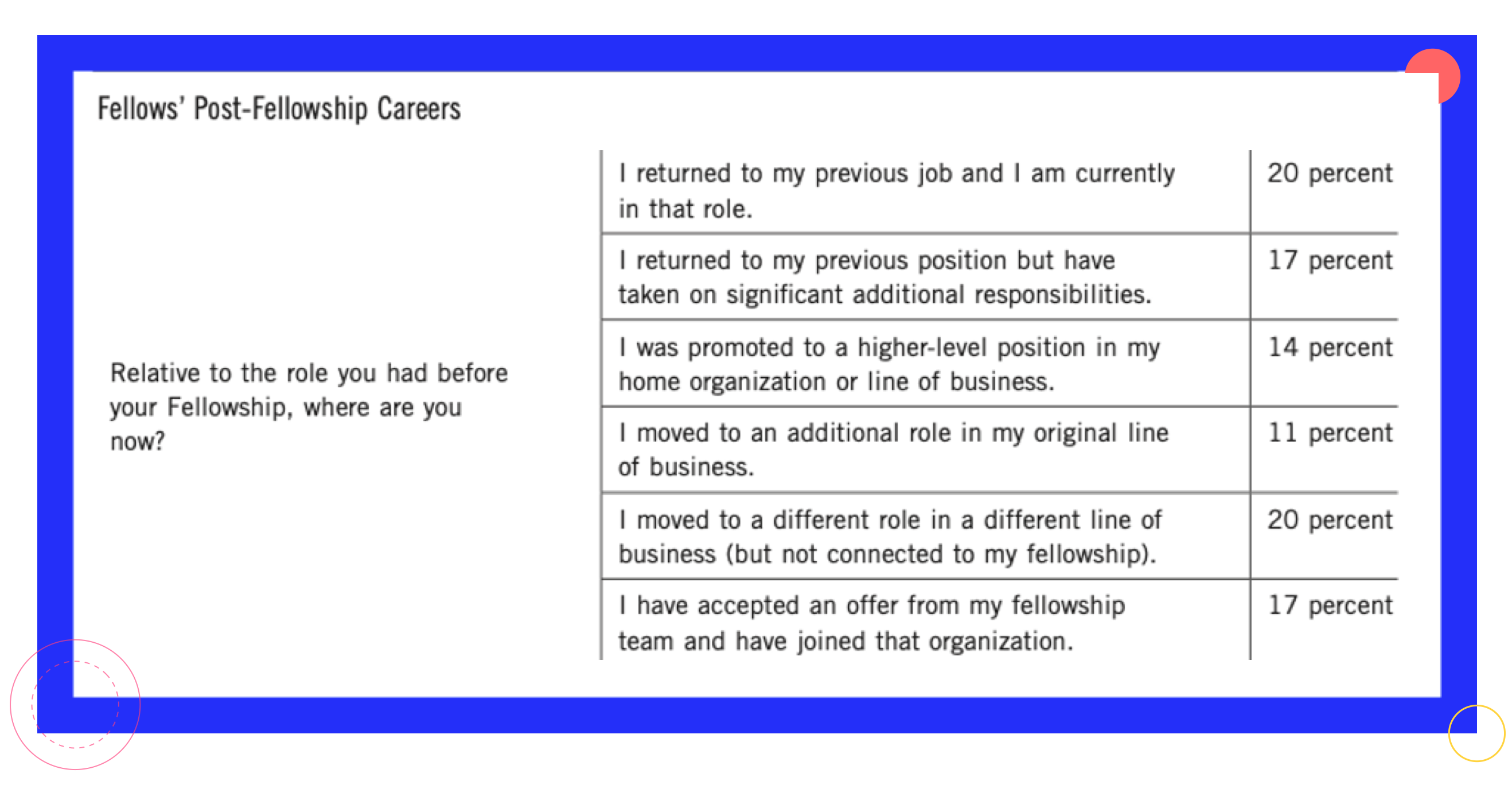
The fellow gains intense knowledge and builds new skills by working in a different position, focusing on key strategic topics. The sending manager gives up an essential resource for six months, although fellow brings new knowledge and connections back to the home team.
Lessons learned/Keys to success:
- Start small, assess results, and improve things each cycle.
- Carefully plan the communication to all stakeholders: candidates, the managers of candidates, receiving team manager/mentors, HR business partners, and global-mobility specialists.
- Define the roles and clarify the expectations for all players.
- Communicate the benefits. It helps market the initiative.
- Work to build executive sponsorship for the initiative. Many managers will welcome the opportunity, yet some will hesitate to give up their best employees while paying their salaries. Emphasize that this is a developmental opportunity for potential future leaders. Enlist the executive sponsorship to emphasize the long-term value of the short-term cost.
- Connect past fellows with current fellows. The former provides the best answers and advice for the latter.
2. GE’s Job-Rotation Program: Corporate Leadership Staff (CLS)
GE’s development system is based on the belief that development comes from experience. Therefore, job-rotation programs have been a primary method at GE for developing both newly hired graduates and more experienced employees. About 48 percent of the members of the Corporate Executive Committee, GE’s top leadership team, experienced a rotational program.
Over time, GE recognized that leaders need intense domain expertise in the technical and business arena. Therefore, they installed Corporate Leadership Staff (CLS) to develop business leaders with industry expertise. CLS program aims to provide high-potential talents with intense operational, commercial, and technical knowledge in non-finance fields.
Candidates should have a bachelor’s degree in engineering, business, or technical field and at least four years of work experience in GE. The participant should demonstrate high performance and have geographic mobility.
GE built several key design features into the program:
- Full-time cross-functional assignments. While participants stay in their business division, they work in roles in different functions.
- Individualized development. CLS is highly customized to the participants. The business assignments are determined based on the improvement area of the individual, considering their business background. Even the rotation period is customized according to the need of the applicant. Program members remain on CLS for two to five years, and program completion is dependent on demonstrating leadership capabilities rather than on spending a specific time in the program or on completing some length assignments. The program consists of a series of full-time jobs that develop the program participants and broaden their horizons. The positions include rotations in multiple functions. For example, one participant with an operations background moved to work in sales and later product management. Participants can also go through an international assignment.
- Capability assessment framework. The consistency across the program is provided by a capability assessment framework, which focuses on five areas: growth, leadership, operational excellence, capital efficiency, and domain expertise. It includes capabilities in these areas that have been identified as required for successful GE business leaders (see the figure below). For each capability, a behavioral definition and a required proficiency level are set. Furthermore, information is provided on possible assignments, projects, and training that can help in developing a selected capability. The same framework is used to assess the skill gaps of the participants and evaluate their progress. Finally, it also serves to evaluate if participants are ready to graduate from the program.
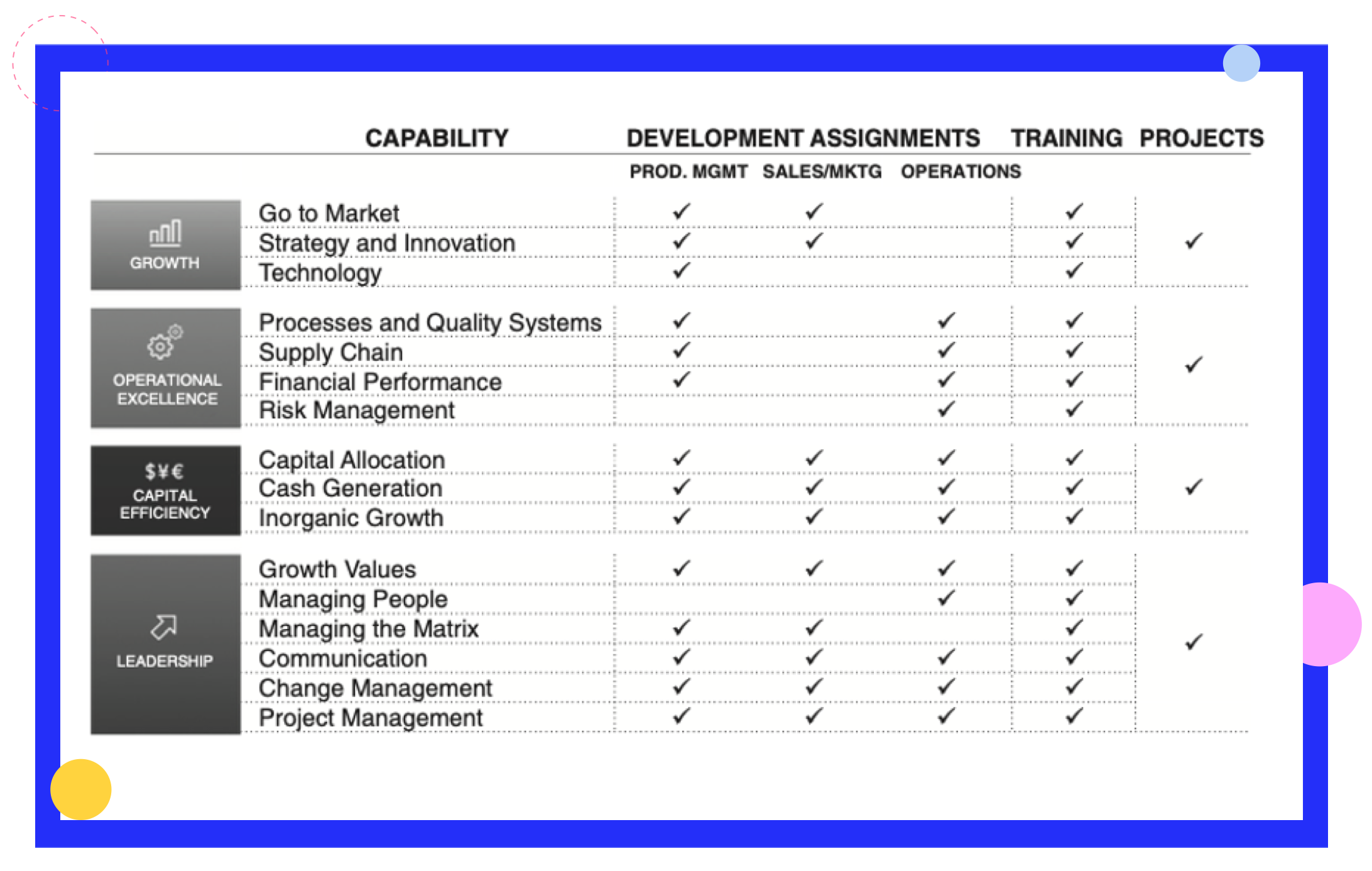
- Leveraging relationships. While in the program, each participant is paired with a senior manager who acts as an executive coach. After the kick-off workshop, the pairs keep frequent contact (every two weeks) to discuss challenges, learning, and progress. Regular feedback and assessments are an integral part of the program. The executive coach helps the participant build an individual development plan that is continually reviewed and adjusted in the light of this feedback.
More than 120 high potentials have participated in the program. Their experience with the program is very positive. As one expressed, “The program moves me into areas I would have never thought of.”
Lessons learned / keys to success:
- The underlying philosophy of the CLS program is the individualization of the learning experience brings the highest impact. This poses a significant challenge for program administration without an IT system. Thus, the program management automated the development plans and developed a tool to track the individual assignments, training, and projects.
- CLS is a global program with very diverse participants from different functions, industries, and geographies. The market realities are significantly different in specific regions, such as China, India, Latin America, and the Middle East. The rotation opportunities are various, the business challenges are other, and candidates have different profiles compared to the more developed markets. The program needs to help participants develop some market-specific leadership skills. Certain experiences may be more important for participants, depending on which market they are coming from. To give an example, in China, the company operates through many joint ventures. Effectively managing a joint venture is vital for future leaders in China, while it has little importance in other markets.
3. Expedia’s Executive Shadowing Program
Upon the research that suggested a large number of executives derail when they move from management to executive positions, Expedia developed an executive shadowing program to provide managers with an overview of the role and a chance to consider whether they want an administrative path in their future.
The program allows the managers to shadow an executive for a day and learn by observing and asking questions. Executives choose a day that includes meetings and activities, providing an overview of their executive responsibilities.
Expedia created a web page on the company intranet, showing the details of the program to both executives and high potential managers. On the intranet, applicants can find:
- a video of senior leaders emphasizing the importance of the program
- profiles of all the executives
- the objective of the program
- an outline of the program
- articles on the importance of executive development
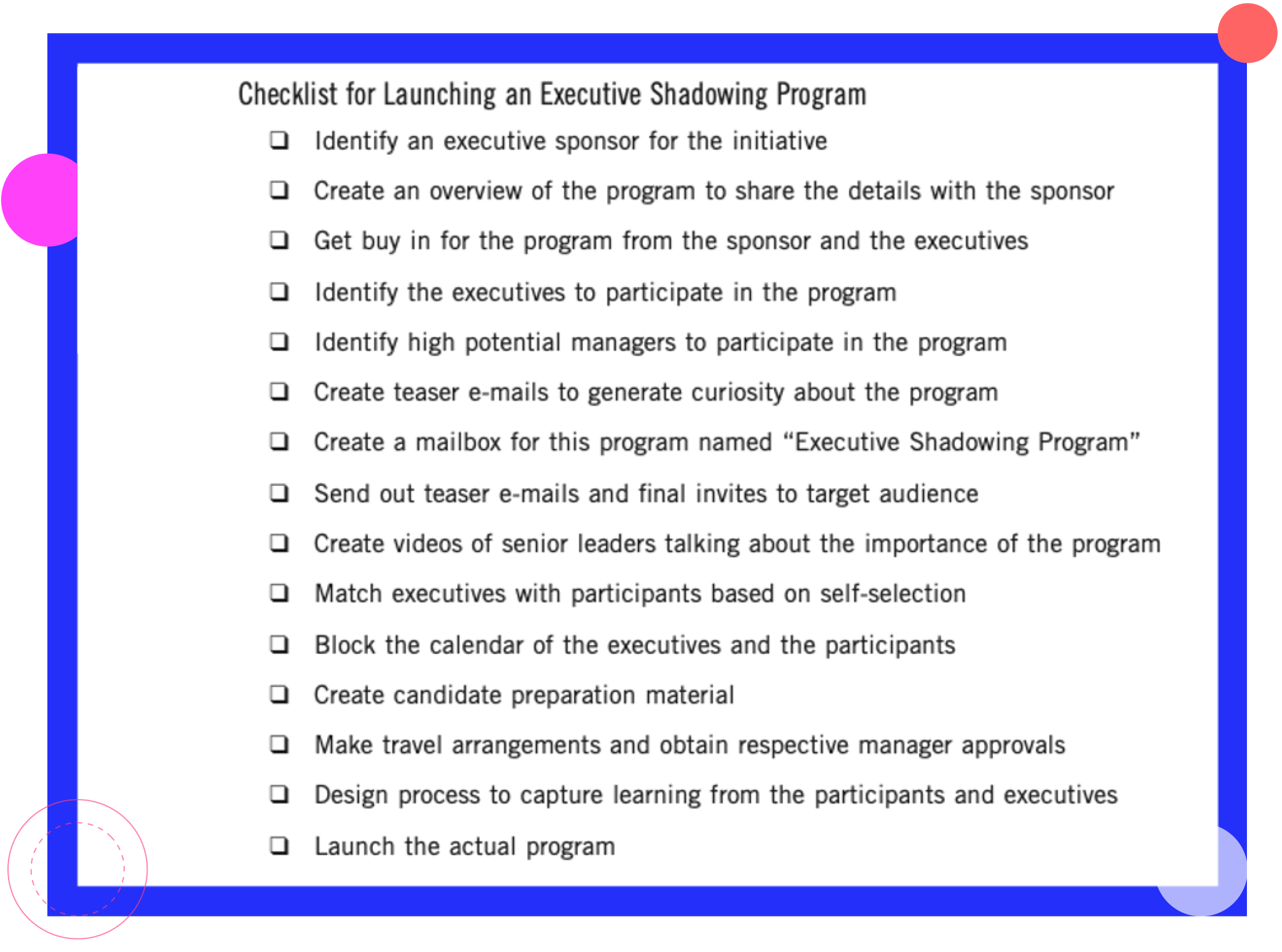
Matching the participants and the executive is an essential step in the shadowing program. After going through the profiles of executives on the web page, participants chose three executives in order of preference. Once matching is completed, the company sends an email to all the participants and executives. The executives are provided with the participants’ profiles and asked to identify a day to share their role in people management, client relationship, stakeholder management, new program, or product development. Moreover, executives are expected to keep a gap of at least thirty minutes between meetings to answer the participants’ questions. Expedia also shares a list of questions/hints that the participants may use to enhance learning during the shadowing session. Feedback showed that the participants accepted the shadowing program’s advantage in understanding executive roles and requested more than a day of shadowing.
Lessons learned / Keys to success:
- In the first program, the executive pool did not completely represent all the skills and backgrounds needed to best match all the high potential managers’ needs. Expedia included additional skills and executives with more diverse backgrounds in the following programs.
- Positioning the program as a valuable piece of the organization’s overall leadership development strategy is crucial. Some of the participants felt that executive shadowing was “bolted on” versus “built-in.”
4. Genentech and Director Development Pathways (DDP)
Following an increased turnover of senior leaders, Genentech, a member of the Roche Group, identified that leaders have an intense need for cross-functional perspectives to understand other functions of the company and its culture. In response, they created Director Development Pathways (DDP), based on basically part-time cross-functional assignments with a strong network of support.
DDP is a process in which participants spend about 10 percent of their time over six to nine months in a host function. Their experiences include job shadowing, observation, special projects, committees and taskforce participation, and joining decision-making meetings. Each participant also receives critical development support from their manager, a functional advisor in the host function, and a coach.
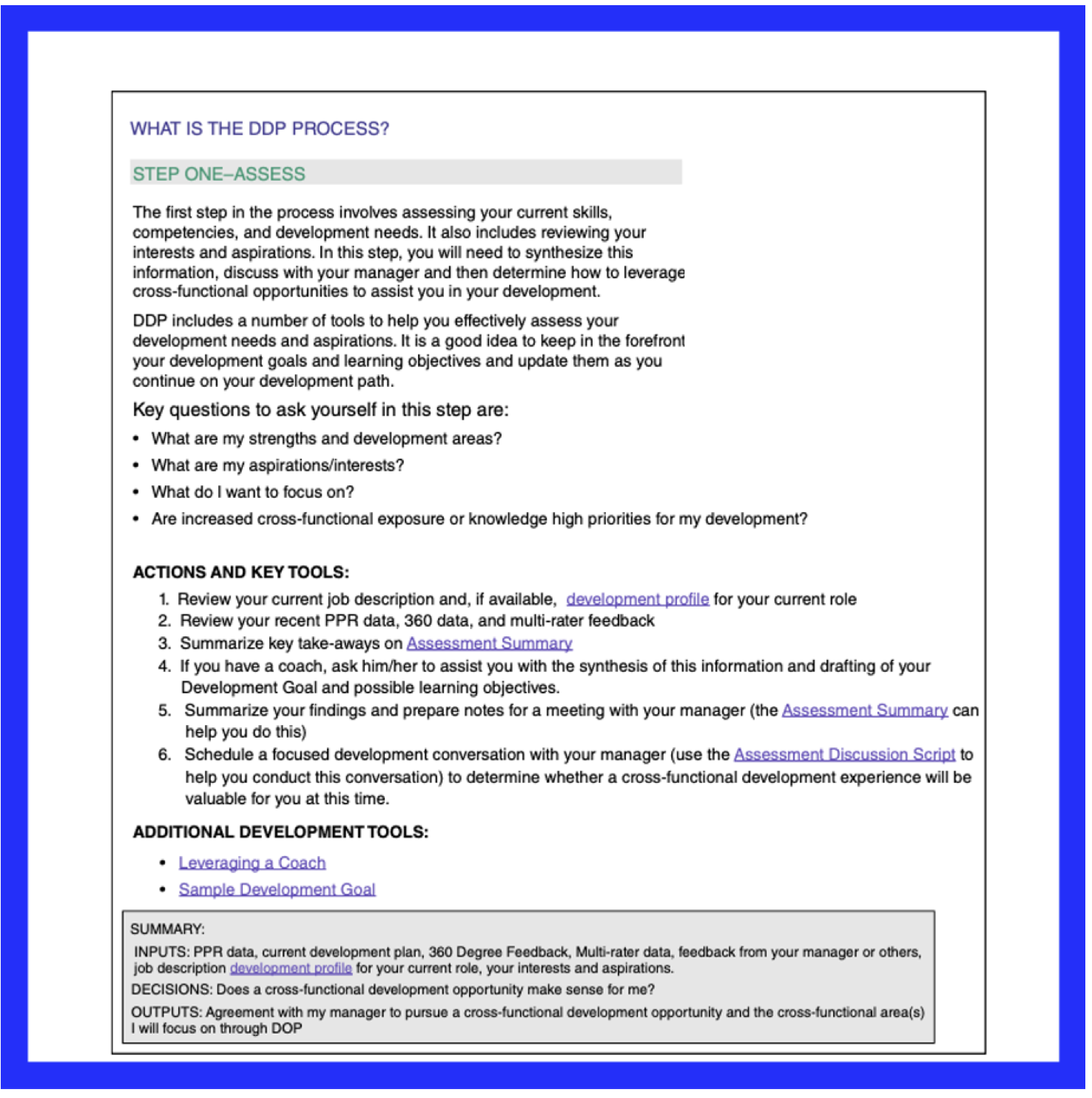
To simplify the application to the program, Genentech created a DDP website (including resources and tools) and determined a basic 5-step process:
Step 1: Assess Strengths, Needs, Interests, and Aspirations
Step 2: Investigate Possible Cross-Functional Opportunities
Step 3: Create a Detailed Action Plan
Step 4: Execute Action Plan
Step 5: Debrief, Reflect, and Apply
Overall, the DDP approach has been well received in the company. With this assignment-based solution, Genentech aims to implement this part-time, assignment-based solution not only for senior leaders but also for fewer senior managers and individual contributors in the future.
Lessons learned / Keys to success:
- Equip directors with the guidance and tools for creating a customized and flexible development plan that fits their situations.
- Create a support network that meets their needs.
- Ensure that they hold and leverage important conversations with their managers and other key people.
[/fusion_text][/fusion_builder_column][/fusion_builder_row][/fusion_builder_container]




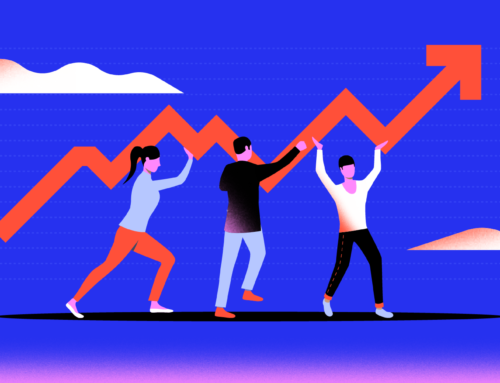

Leave A Comment